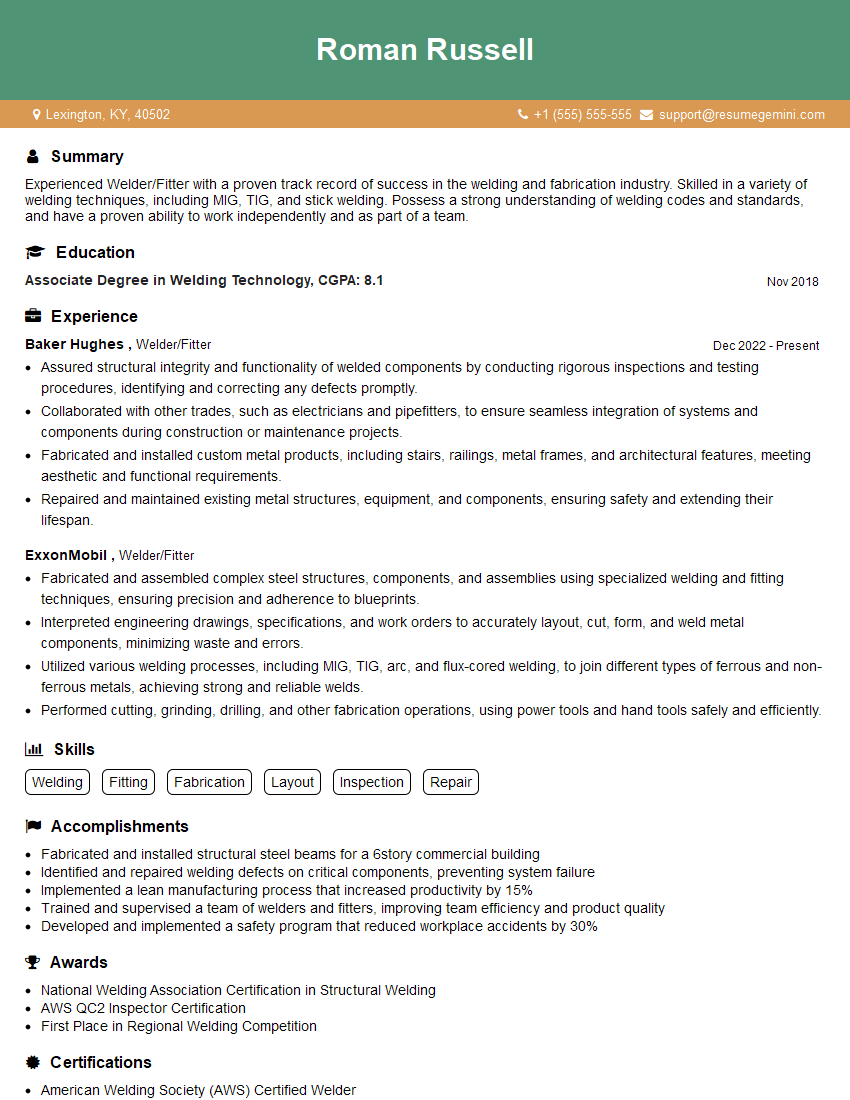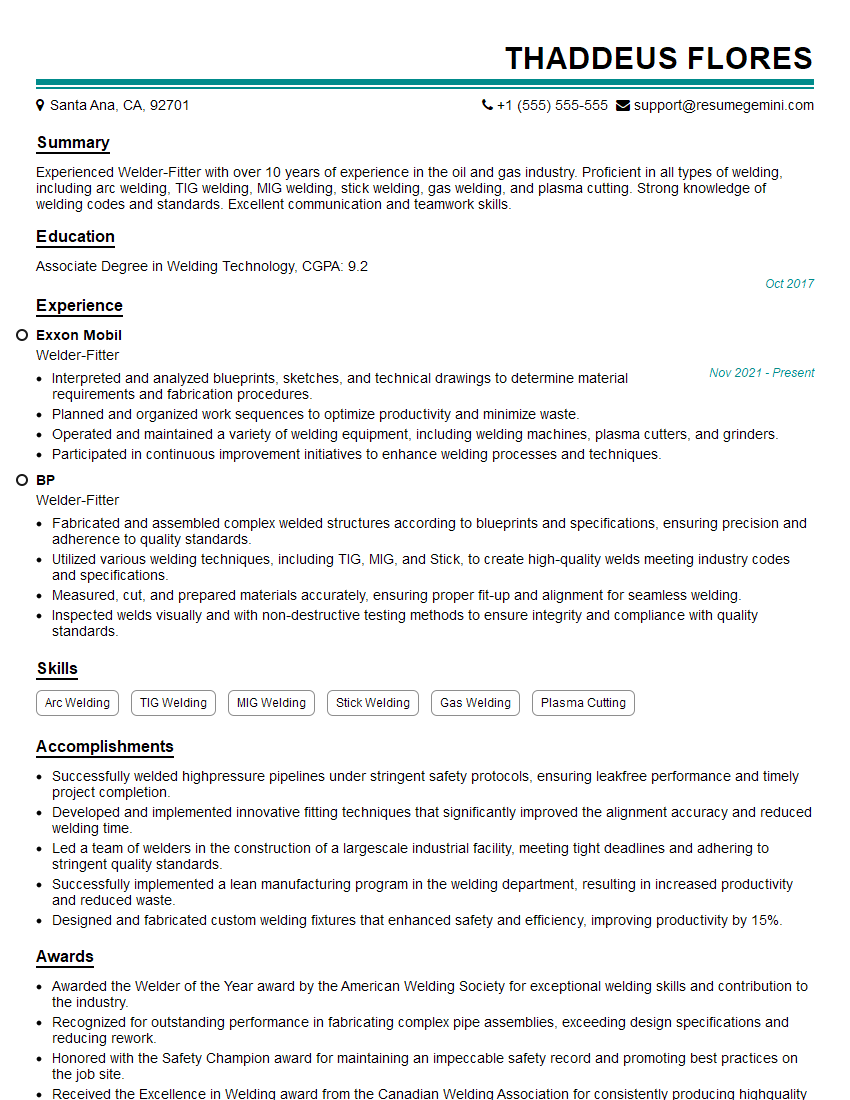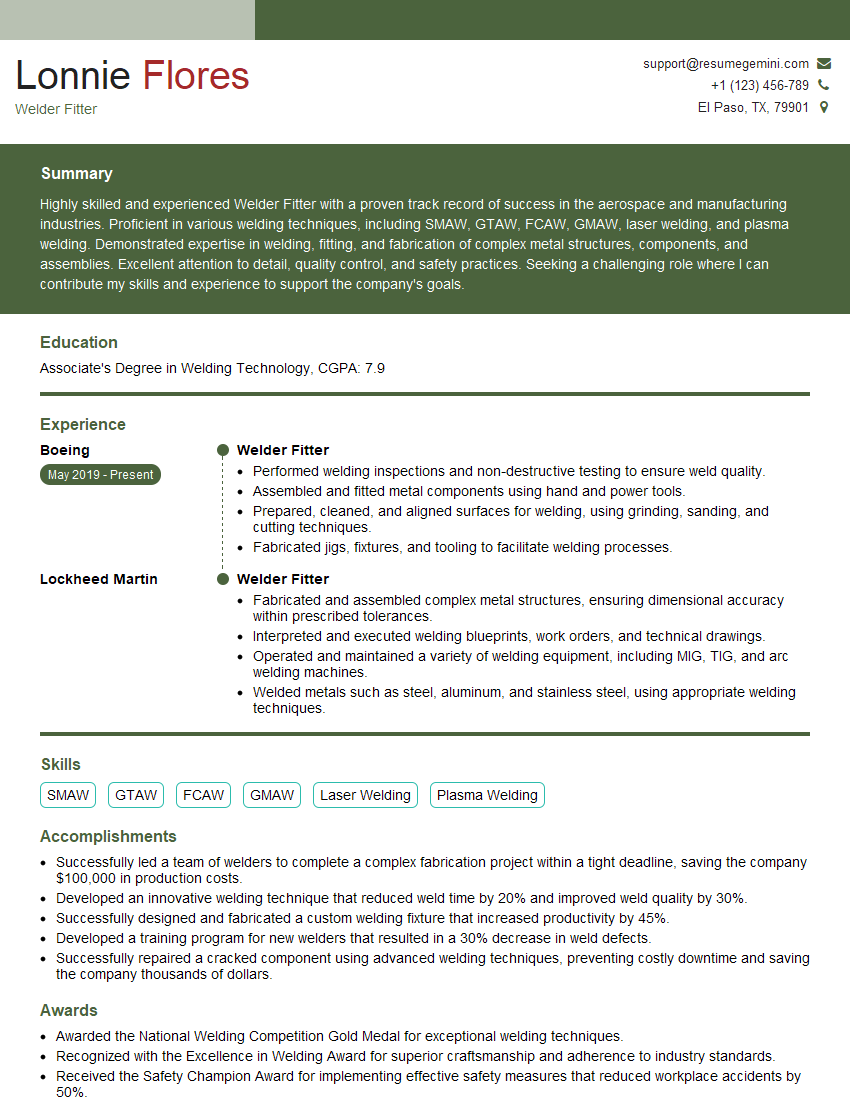Ever felt underprepared for that crucial job interview? Or perhaps you’ve landed the interview but struggled to articulate your skills and experiences effectively? Fear not! We’ve got you covered. In this blog post, we’re diving deep into the Welder/Fitter interview questions that you’re most likely to encounter. But that’s not all. We’ll also provide expert insights into the key responsibilities of a Welder/Fitter so you can tailor your answers to impress potential employers.
Acing the interview is crucial, but landing one requires a compelling resume that gets you noticed. Crafting a professional document that highlights your skills and experience is the first step toward interview success. ResumeGemini can help you build a standout resume that gets you called in for that dream job.
Essential Interview Questions For Welder/Fitter
1. Describe the different types of welding processes you are familiar with.
I have experience with a variety of welding processes, including:
- Arc welding (SMAW, GMAW, GTAW)
- MIG welding
- TIG welding
- Plasma cutting
- Oxy-fuel welding
2. What is the difference between a welder and a fitter?
Welder
- Joins metal pieces together using heat.
- Uses various welding processes to create strong and durable joints.
- May also be responsible for preparing metal surfaces for welding.
Fitter
- Prepares metal pieces for welding by cutting, bending, and shaping them.
- Ensures that the pieces fit together properly before welding.
- May also work with welders to ensure that joints are properly made.
3. What are the key factors to consider when selecting a welding process?
The key factors to consider when selecting a welding process include:
- The type of metal being welded
- The thickness of the metal
- The desired strength of the joint
- The cost of the equipment and materials
- The availability of skilled welders
4. What are the most common welding defects and how can they be prevented?
The most common welding defects include:
- Porosity
- Inclusions
- Undercutting
- Cracking
- Distortion
These defects can be prevented by using proper welding techniques, selecting the right welding process and materials, and following proper safety procedures.
5. What is the importance of using proper safety equipment when welding?
Using proper safety equipment when welding is important to protect yourself from the following hazards:
- Arc flash
- Fumes and gases
- Heat and sparks
- Electrical shock
- Eye damage
Proper safety equipment includes a welding helmet, gloves, apron, and respirator.
6. What is the best way to improve your welding skills?
The best way to improve your welding skills is to practice regularly. You can also improve your skills by:
- Taking welding classes
- Reading books and articles about welding
- Watching welding videos
- Working with experienced welders
7. What are the different types of welding joints?
The different types of welding joints include:
- Butt joint
- Edge joint
- T-joint
- Corner joint
- Lap joint
The type of joint used depends on the application and the strength required.
8. What is the difference between a fillet weld and a groove weld?
A fillet weld is a weld that is made between two surfaces that are at right angles to each other. A groove weld is a weld that is made between two surfaces that are parallel to each other.
9. What is the best way to prepare metal for welding?
The best way to prepare metal for welding is to clean and remove any dirt, grease, or rust from the surface. You can do this by using a wire brush, sandpaper, or a chemical cleaner.
10. What are the different types of welding codes?
There are many different welding codes, each with its own specific requirements. Some of the most common welding codes include:
- American Welding Society (AWS) D1.1
- American Society of Mechanical Engineers (ASME) Boiler and Pressure Vessel Code
- Canadian Welding Bureau (CWB) W178
- International Organization for Standardization (ISO) 3834
Interviewers often ask about specific skills and experiences. With ResumeGemini‘s customizable templates, you can tailor your resume to showcase the skills most relevant to the position, making a powerful first impression. Also check out Resume Template specially tailored for Welder/Fitter.
Career Expert Tips:
- Ace those interviews! Prepare effectively by reviewing the Top 50 Most Common Interview Questions on ResumeGemini.
- Navigate your job search with confidence! Explore a wide range of Career Tips on ResumeGemini. Learn about common challenges and recommendations to overcome them.
- Craft the perfect resume! Master the Art of Resume Writing with ResumeGemini’s guide. Showcase your unique qualifications and achievements effectively.
- Great Savings With New Year Deals and Discounts! In 2025, boost your job search and build your dream resume with ResumeGemini’s ATS optimized templates.
Researching the company and tailoring your answers is essential. Once you have a clear understanding of the Welder/Fitter‘s requirements, you can use ResumeGemini to adjust your resume to perfectly match the job description.
Key Job Responsibilities
As a Welder/Fitter, your responsibilities will entail the following key tasks:
1. Welding and Fabrication
Your primary duty is to perform welding and fabrication tasks in accordance with established standards and procedures. This includes:
- Welding various metals using different welding techniques (e.g., MIG, TIG, arc welding)
- Fabricating and assembling metal components and structures
- Ensuring high-quality welds that meet specifications and industry standards
2. Fitting and Assembly
You will also assist in fitting and assembling metal components:
- Measuring, cutting, and shaping metal pieces to ensure proper fit and alignment
- Assembling and aligning metal parts for welding and fabrication
- Utilizing jigs and fixtures to maintain accuracy and precision
3. Inspection and Quality Control
Regularly performing inspections and quality control checks is crucial:
- Inspecting welds for defects or imperfections
- Conducting quality checks on fabricated components and assemblies
- Adhering to established quality standards and specifications
4. Maintenance and Equipment Operation
You are expected to maintain and operate welding equipment effectively:
- Properly setting up and maintaining welding equipment
- Troubleshooting and repairing welding equipment as needed
- Maintaining a clean and organized work area
Interview Tips
To prepare effectively for your Welder/Fitter interview, consider the following tips:
1. Research the Company and Industry
Familiarize yourself with the company’s history, values, and products or services. Research the specific industry to understand current trends and best practices.
2. Practice Your Welding Skills
Ensure you showcase your welding skills. Bring examples of your work or offer to demonstrate your abilities during the interview. Highlight any certifications or training you have completed.
3. Understand Welding Codes and Standards
Be prepared to discuss your knowledge of welding codes and standards such as ASME or AWS. Demonstrate your understanding of how these codes impact your work.
4. Highlight Your Attention to Detail
Emphasize your attention to detail and commitment to quality. Provide examples of how you ensure precision and accuracy in your welding and fabrication tasks.
5. Prepare for Technical Questions
Expect questions about welding techniques, equipment operation, and safety procedures. Be ready to articulate your understanding of these aspects.
6. Be Enthusiastic and Professional
Demonstrate your passion for welding and your commitment to the field. Be professional, articulate, and enthusiastic throughout the interview.
Next Step:
Now that you’re armed with interview-winning answers and a deeper understanding of the Welder/Fitter role, it’s time to take action! Does your resume accurately reflect your skills and experience for this position? If not, head over to ResumeGemini. Here, you’ll find all the tools and tips to craft a resume that gets noticed. Don’t let a weak resume hold you back from landing your dream job. Polish your resume, hit the “Build Your Resume” button, and watch your career take off! Remember, preparation is key, and ResumeGemini is your partner in interview success.


